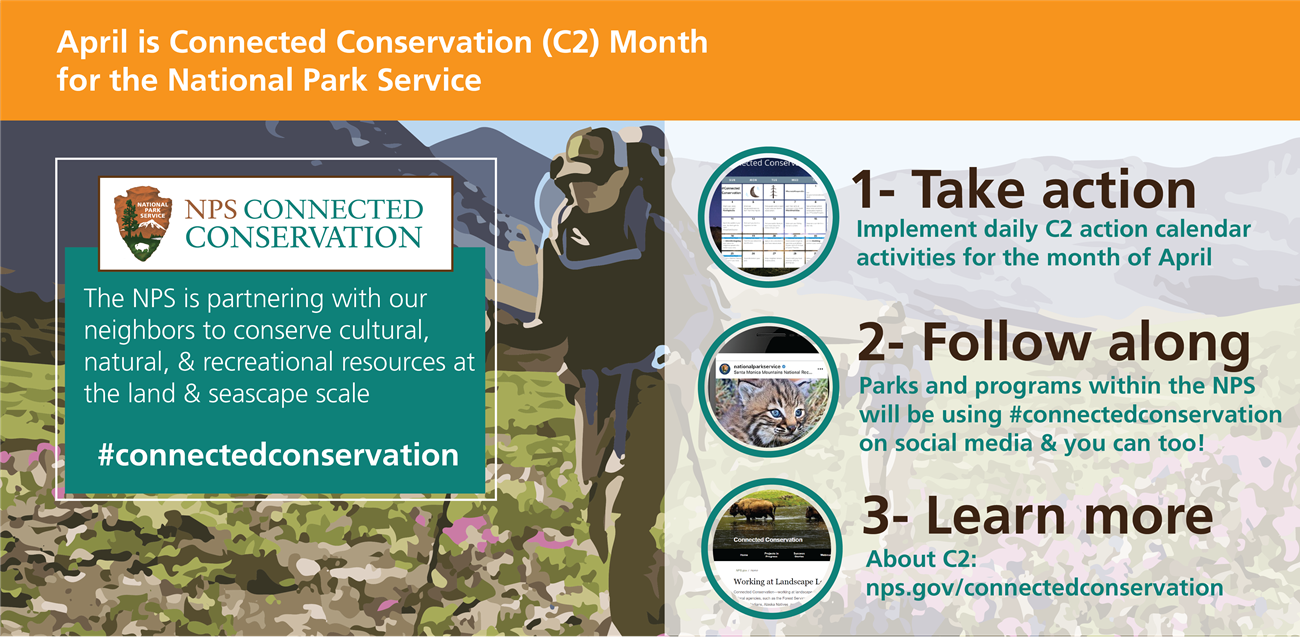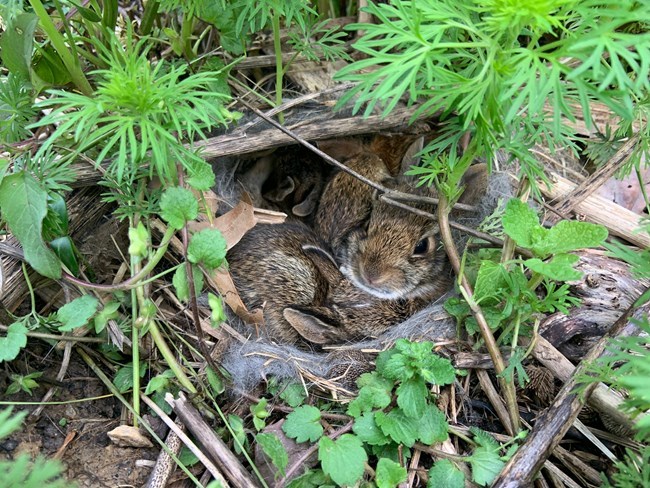
In the background, a person hikes through a mountain valley while holding hiking poles. A square overlays the image and contains the following information: An arrowhead logo next to NPS Connected Conservation,The NPS is partnering with our neighbors to conserve cultural, natural, and recreational resources at the land and seascape scale #connectedconservation.
Another square overlays the image and includes a numbered list of directions, each accompanied by a circular image. Thumbnail image of a calendar next to 1-Take Action, Implement daily C2 action calendar activities for the month of April. Thumbnail image of a bobcat next to 2-Follow along, Parks and programs within the NPS will be using #connectedconservation on social media & you can too! Thumbnail of a screenshot of webpage with a photo of bison next to 3-Learn more, About C2: nps.gov/connectedconservation.

Courtesy Ted White
Featured Projects
April 30: Gardening for Wildlife with Native Plants
Native plant gardening is a fantastic way to enjoy some national park-style nature observation without ever leaving your yard, and a great way to partner with the National Park Service in preserving biodiversity.
April 29: Desert Bighorn Sheep
The Mojave Desert spans across California, Arizona, and parts of Nevada and Utah. Take a moment to think about the mountains in the distance you see out the car window. These groups of mountains act as sky islands where many plants and animals survive and thrive in the desert. One of the species that call these mountain islands home is the desert bighorn sheep (Ovis canadensis nelsoni). Read Desert Bighorn Sheep: Connecting a Desert Landscape.
April 28: Traditional Ecological Knowledge
Traditional Ecological Knowledge (TEK) is the on-going accumulation of knowledge, practice and belief about relationships between living beings in a specific ecosystem that is acquired by indigenous people over hundreds or thousands of years through direct contact with the environment, handed down through generations, and used for life-sustaining ways.
April 27: Condor Conservation
California condors once roamed the skies along the entire California coast and into the Pacific Northwest, but Soon Condors Will Soar Over Redwoods.
April 26: Rivers, Trails, and Conservation Assistance Program
Our national network of conservation and recreation planning professionals partners with community groups, nonprofits, tribes, and state and local governments to design trails and parks, conserve and improve access to rivers, protect special places, and create recreation opportunities.
April 25: National Trails System
On this springtime Sunday, perhaps a hike or nature walk is in order. The National Park Service has you covered with a variety of trails for all abilities. Wherever you go, remember to #RecreateResponsibly: stay on the trail, pack out all your trash, and follow the rules of the trail.
April 24: National Heritage Areas
National Heritage Areas are a grassroots, community-driven approach to heritage conservation and economic development. Through public-private partnerships, NHA entities support historic preservation, natural resource conservation, recreation, heritage tourism, and educational projects. In 2020, National Heritage Areas made real impacts in their communities; a new report shows their impact by the numbers.
April 23: Citizen Science - Dragonfly Mercury Project
The Dragonfly Mercury Project is a nationwide program that pairs scientific efforts to understand mercury pollution risks with public engagement and education. Mercury is a toxic contaminant that threatens human and wildlife health, arriving in even remote national parks through rain and snow. Dragonfly larvae serve as indicators of mercury contamination in fish and throughout aquatic food webs. Every year, national parks work with community and citizen scientists to collect dragonfly larvae for this study. Watch the video, explore the story map, and see what we've learned.
April 22: Earth Day!
The National Park Service monitors air quality and works to improve it; this work benefits neighbors to parks, too. Over the past few decades, the average distance Shenandoah National Park visitors can see has improved dramatically, from 35 miles in 1990 to 80 miles in 2018. Learn more about this work: Taking the Long View: Clean Air, Clear Views.
April 21: Sounds Know No Bounds
The National Park Service’s Natural Sounds Program protects the acoustic environment that is essential to the integrity of park ecosystems and enjoyment of our visitors. The National Park Service protects natural and cultural “soundscapes,” everything from rushing waterfalls to bird songs.
April 20: Bison Conservation Initiative
The Department of the Interior manages approximately one-third of North America’s wild bison. National Park Service, US Fish and Wildlife Service, and Bureau of Land Management lands support ~11,000 bison in 19 herds across 12 states. Together with the Bureau of Indian Affairs and the US Geological Survey, these DOI agencies share stewardship of bison, in pursuit of the following goals: Wild, healthy bison herds, genetic conservation, and ecological and cultural restoration. Bison Connect Us
April 19: Birds and Climate Change in National Parks
In 2018, researchers from the National Audubon Society and the National Park Service published a study that detailed the projected effects of climate change on birds in national parks. They found that a park may see a 23% change (averaged over 274 parks) in bird species by the middle of this century.
April 18: World Heritage Sites
The primary purposes of the World Heritage Convention are to enhance worldwide understanding and appreciation of our shared heritage and through international cooperation help preserve a relatively small number of exceptional natural and cultural properties around the world that have been formally determined to possess “outstanding universal value” to humanity. World Heritage Sites in the United States: A Perspective from the National Park Service
April 17: Bat Appreciation Day
In response to the growing recognition that we needed more and better data on our park bats, ecologists in several parks and Inventory & Monitoring Networks joined with the US Geological Survey, universities, state agencies, and other federal land management agencies to implement the North American Bat Monitoring Program (NABat) to parks and neighboring lands across the West. To centralize coordination efforts, the Northwestern Bat Hub was established on the Oregon State University-Cascades campus.
April 16: Citizen Science
The COVID-19 pandemic has brought challenges into just about every aspect of our lives and communities, even including citizen science projects. At Glacier National Park, the small volunteer force focused their attention on the Common Loon and High Country Citizen Science Projects, collecting population size and distribution data on Common Loons, mountain goats, and bighorn sheep within the park. In addition to these seasoned volunteers, the program hosted two outreach groups–a Montana Conservation Corps crew and a group of Groundwork USA youth volunteers. The Northwestern Bat Hub: Banding Together for Bat Monitoring Across the West
April 15: Marine Mammal Strandings
The Outer Banks of North Carolina, known for history, hurricanes, and shipwrecks also happen to be a hotspot for marine mammal activity. Recorded strandings date back to 1884, so it can be argued that the Outer Banks has the longest running record of marine mammal strandings in the world. The National Park Service works with partners to respond to live and dead marine mammals. And join us today, April 15, at 3 p.m. EDT for Marine Mammal Strandings & Tribal Relationships.
April 14: Wildlife Crossings
Lions in the Santa Monica Mountains survive in an increasingly fragemented and urbanized landscape. The long-term survival of a mountain lion population here depends on their ability to move between regions to maintain genetic diversity and overall population health. A solution to address this issue—a wildlife crossing across the 101 Freeway, the biggest barrier between the Santa Monica Mountains and other large natural areas—is currently being drafted by Caltrans. A private fundraising initiative, Save LA Cougars, is raising money for the effort. If a wildlife crossing was built across the freeway, it would allow for mountain lions living north of the Santa Monica Mountains to travel into the range and for animals living south of the freeway to disperse out of the area. A joint UCLA and National Park Service study recently found that the mountain lion population faces possible extinction.
April 13: Wild and Scenic Rivers
Across the country, efforts have been underway to remove dams that have outlived their intended purpose and have detrimental ecological effects or pose a safety hazard. On White Clay Creek (WCC) Wild and Scenic River, the successful removal of the first of seven dams has opened the way for improved ecosystem health and fish passage.
April 12: Critical Connections for Birds and Arctic Animals
Conserving migratory species is a great challenge for the National Park Service. Learn about research at Denali National Park, recommendations for further reading, and a photo album of migratory species at Critical Connections.
April 11: Keeping Out Aquatic Invasive Species in the Crown of the Continent
The staff at the Crown of the Continent work with partners including the State of Montana, Canadian provinces British Columbia and Alberta, the United States Forest Service, and the University of Montana as well as the Blackfeet Nation and Confederated Salish and Kootenai Tribes to keep invasive aquatic species out.
April 10: U.S. Biosphere Network
The Mammoth Cave Biosphere Region has been hard at work, creating lots of cool videos and story maps to explain the value of the region to the nearby community. Mammoth Cave Biosphere RegionConnected Conservation Month
Last updated: April 30, 2021
